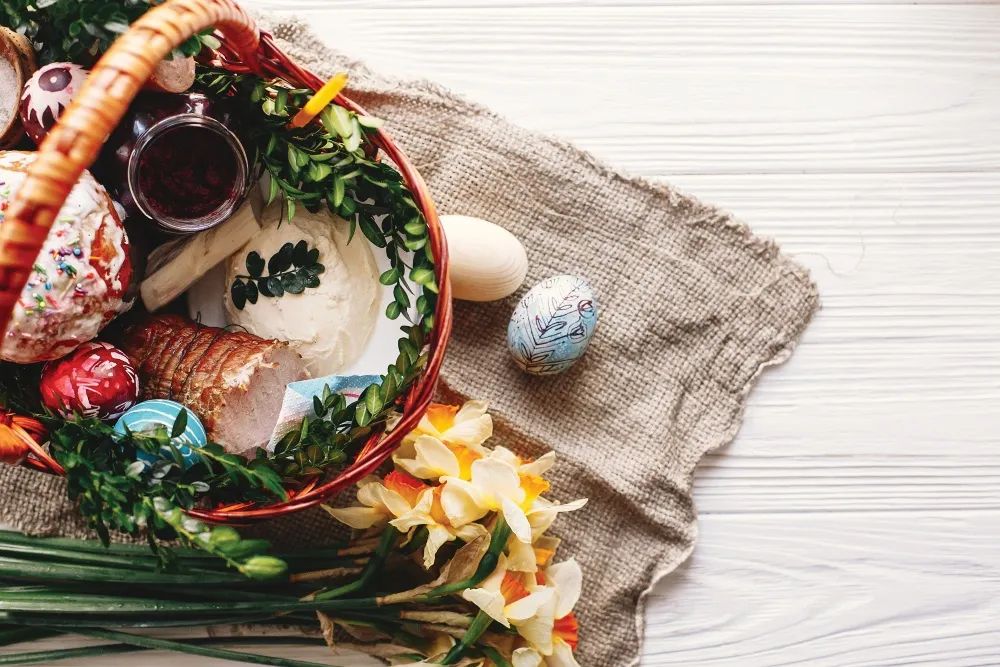
Easter Eats: A Taste of Tradition
March 2024
by renata haidle
In 2022, the mayor of Billings, Bill Cole, started a wonderful tradition: the World Languages Dinner - an event that brought together people speaking 48 different languages (per 2023 data). However, they are not foreigners or tourists. They all live in Billings, and call the United States their home. With so much ethnic and cultural diversity, Billings has become a true melting pot where traditions from all over the world meld with the American way of life. And since Easter is fast approaching at the end of this month, I couldn't help but wonder: how do different cultures celebrate this special Christian holiday? This article does not intend to be exhaustive, of course. Rather, it is meant to barely whet your appetite, if you’ll pardon the pun.
Greek Pascha
For the Greek Orthodox, Pascha (Easter) is a deeply religious and festive occasion. The Easter table is adorned with a plethora of delicacies, with lamb - roasted or slowly cooked - being the star of the show. Other dishes include:
- Tsoureki - a sweet, braided bread flavored with orange zest and topped with slivered almonds.
- Magiritsa - a soup made from lamb offal, tripe, and liver, as well as romaine lettuce. It is designed to use the less desirable parts of the lamb, so nothing goes to waste..
- Kokoretsi - a traditional dish made from lamb or goat offal, such as liver, heart, and lungs, which are skewered and grilled.
- Not specifically Greek but present on the table nonetheless, hard-boiled eggs dyed red symbolize the blood of Christ. Tradition requires everyone at the table to pick up an egg and try to crack someone else’s. It is a game enjoyed by kids and adults alike. The hard shell represents the sealed tomb, while the cracking symbolizes Christ’s resurrection, as well as life and rebirth.
Mexican Semana Santa (Holy Week)
As Easter approaches, Mexican households come alive with the aromas of traditional dishes. Specific foods vary by region of origin, but there are some common denominators. Capirotada is a sweet and savory bread pudding made with layers of bread, cheese, nuts, and dried fruits. It's often served during Lent and Easter. Roast lamb is a staple for Domingo de Pascua (Easter Sunday). Another popular dish is Bacalao a la Vizcaína, a rich codfish stew that reflects the influence of Spanish culinary traditions.
Slavic Velikonoce/Velykden/Wielkanoc (Big Night)
Slavic countries embrace Easter with a diverse array of customs and culinary delights. Paska, a sweet bread with a high egg content, is a common sight in Eastern European households. Polish babka is a similar sweet bread; it can be plain, infused with rum extract, or filled with various ingredients like nuts, poppy seeds, or dried fruits. Ukrainian pysanky are beautifully decorated Easter eggs, dyed with vibrant colors and adorned with intricate designs. Šunka U Kruhu (ham in bread) is a Croatian dish usually served with Easter eggs, scallions, and horseradish sauce.
German Ostern
The paschal sweet bread makes an appearance on German tables as well. Named osterbrot (Easter bread) or osterzopf (Easter bun), it is light in texture and filled with currants and almonds. Roast lamb or ham are also common, often accompanied by Kartoffelsalat (potato salad) and various spring vegetables.
Scandinavian Påske
Scandinavians usher in Easter with a blend of old and new traditions. In Sweden, the Smorgastarta, a savory, layered, sandwich cake with smoked salmon and cream cheese, is a modern favorite. Meanwhile, Norwegians favor roasted lamb, chocolate, and oranges. Oh, and did you know that Norwegians’ favorite pastime at Easter is curling up with a good crime novel and drinking hot chocolate? Après le ski, of course.
French Pâques
The French celebrate Easter with culinary finesse, presenting a delightful spread of roasted lamb seasoned with garlic and herbs like rosemary and thyme, oven-roasted potatoes, asparagus, artichokes, and haricots verts (green beans). For dessert, expect gâteau de Pâques (Easter cake), which is a chocolate sponge cake usually decorated with chocolate eggs and bunnies.
Brazilian Páscoa
In Brazil, Easter is a time of joy and festivity, with a strong emphasis on sweets. Brigadeiros, truffles made from condensed milk, butter, and cocoa powder, are a ubiquitous treat. Additionally, the Bolo de Páscoa, a rich chocolate cake, often conceals a surprise inside—a symbol of new life and resurrection. Quindins are small custard treats made with egg yolks, butter, grated coconut, and sugar. Feijoada, bean stew with bits of beef and pork, is usually served with rice and sausages.
Asian Easter: A Fusion of Cultures
Across Asia, diverse cultures bring their unique flavors to Easter celebrations. In the Philippines, the succulent Lechon (roast pig) is a symbol of bounty and prosperity. In South Korea, the celebration may include bibimbap, bulgogi, and chicken wings, while in India, Easter is often marked with the traditional aromatic curries and spiced rice dishes that make Indian cuisine so wonderfully flavorful.
Many of the dishes mentioned above hold religious significance, serving as a tangible link between faith and food. The lamb, appearing in just about all European cuisines, symbolizes Christ's sacrifice. Eggs, featured prominently across the world, represent new life and resurrection, while bread is a reminder of the body of Christ.
As we journey through these diverse Easter culinary traditions, it becomes clear that on this sacred day religious observances are intertwined with the rich array of flavors that grace our tables. Each dish, rooted in cultural heritage and religious symbolism, serves as a testimony of the universal themes of sacrifice, rebirth, and celebration.
Originally printed in the March 2024 issue of Simply Local Magazine
Never miss an issue, check out SLM's digital editions here!





